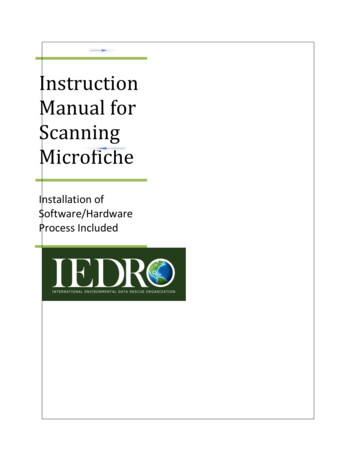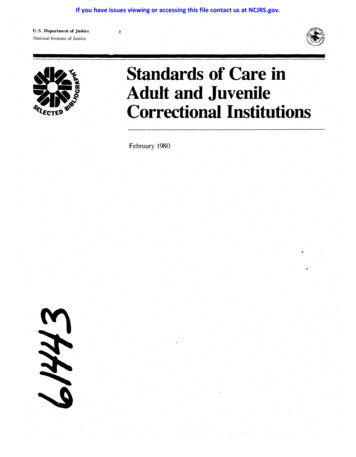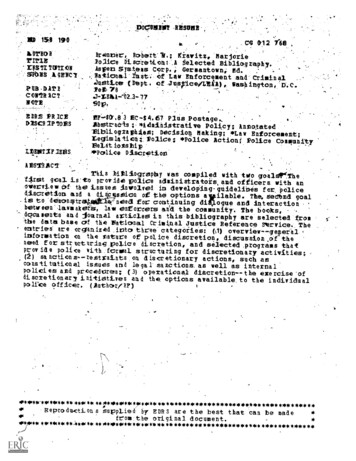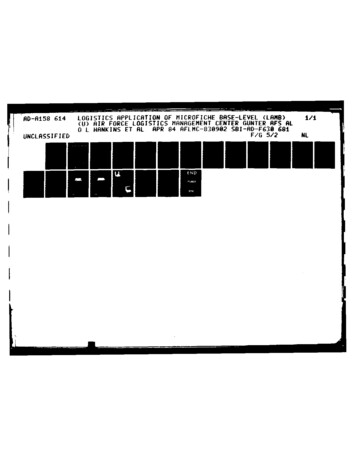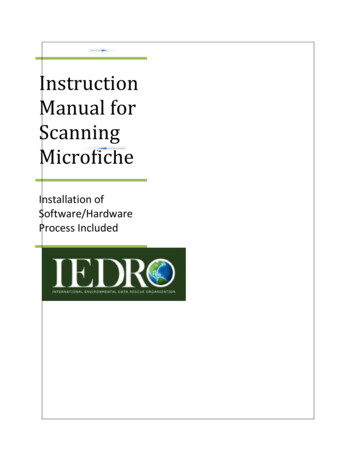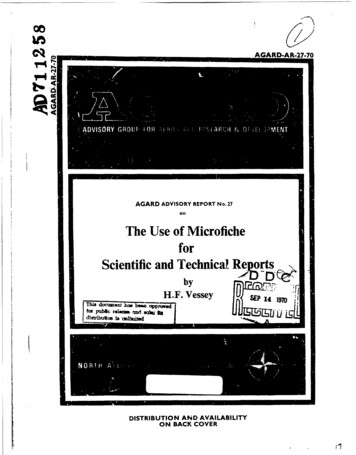
Transcription
AGARD-AR-27-70AGARDADVISORY REPORT No. 27onThe Use of MicroficheforScientific and Technical RepotbyH.F. VesseyThis documisrl masi.10Medi tbbula is tm1buiWfpublitIUYSalo.IJDISTRIBUTION AND AVAILABILITYON BACK COVERu19014 19104 E A3T
AGARD Advisory Report No. 27NORTH ATLANTIC TREATY ORGANIZATIONADVISORY GROUP FOR AEROSPACE RESEARCH AND DEVELOPMENT(ORGANISATION DU TRAITE DE LIATLANTIQUE NORD)THE USE OF MICR:OFICHE FOR SCIENTIFIC AND TECHNICAL REPORTSbyH. F. Vessey) 0 '-SEPThis report was prepared at t.he request of the Technical Panelcf AGARD -NATO.19g7 0:
The material in this publication has been reproduced directly fromcamera ready copy supplied by the author.Published August 1P70778. 142:06.055Printed by Technical Editng and Reproductton LtdJarforn House, 7-9 Charlotte St. London. ViP IM)ii
SUMMARYThis paper considers the use of the 105 x 148 mm microfiche forthe report material of NATO Nations, It emphasises the economies thatare obtained once user acceptance has been obtained and discusses the reluctance of scientists to use this report material which requires a specialreader. Readers and reader printers are discussed and advice is givenon the examination and test of a new reader or reader printer. The largenumber of proposed "standards" for microfiche are outlined and it is statedthat the present 105 x 148 mm microi ,eis adequate and that there is littleconflict between European and American standards. Much of the Americanreport material is already available in Europe only as microfiche and theproportion is expected to grow and it is therefore recommended that European Documentation Centres should produce their own reports as microficheand encourage their customers to make full use of this material. Betterand many more readers are stated to be required in firms, Universitiesand Laboratories and some advice on minimum numbers is given. Possibleaction by AGARD is discussed.iii
CONTENTSINTRODUCTIONMICROFICHE STANDARDSTHE ECONOMICS OF MICROFICHEOTHER FORMS OF MICROFICHECHOICE OF MICROFICHE FOR REPORTUSER ACCEPTANCE24LITERATURE56READERS7READER PRINTERS8COPYING MICROFiCHE9MAKING MICROFICHE10PRINTING FROM MICROFICHESCALE OF EQUIPMENT REQUIREDRECOMMENDATIONS111213REFERENCESAPPENDIXiv
1. INTRODUCTIONMicrofiche are sheets of cut film on which a number of photographic images are printed. Thesize of those discussed here is 105 x 148 mm or about 4 x 6 in. but many other sizes are in existence.Microfiche were introduced in Europe in 1940 but it was not until a few years ago that they were producedin large quantities when ths form of micro-image was introduced in America by the A. E. C. and NASA.All the large American Aerospace organisations are now making and using microfiche which, in thisarea, have replace' microfilm (16 mm or 35 mm film) and, to a large extent, hard copy. As a reportis reduced to a single sheet of film there is R considerable saving in cost and there is no doubt that theuse of microfiche will continue to expand and it is already true that many American reports are onlyavailable in Europe as microfiche (or P a very expensive photocopir's of microfiche). In addition,most of the AGARD documents not on sale have been put on microtch in America and are availableto the general public. Thus many of these papers (issued as hard copy in limited numbers) can onlybe obtained as microfiche. Availability of these and other American micr.-ficfc has been considerablyimproved and most can now be bought from .SiAO/ELDO in Paris and from the Ministry of TechnologyReports Centre, Rtation Square Houee, St. Mary Cray, Orpington, Kent BR5 3RE, United Kingdom.The purpose of this report is to explain the advantages of microfiche and to encourage the fulluse of them in the report literature of all NATO nations.2. MICROFICHE STANDARDSThere is a bewildering number of standajds and so called standrds in microfiche. In theconte. of reports the most important are I. S. 0 and British Standards in Europ'i and Federal StandardsC in the U.S.A. and fortunateiy in practice they are compatible in the 105 x 148 mm size. Thereare variations which will be discussed later but fortunately all three can be used with suitable readingand printing equipment even if !uly automatic. Dimensions and tolerances from ref. 3 are shown infig. 1 while figs. 2 and 3 indicate the image layout. It will be seen that while 72 image areas areavailable not all are used. Thus a title strip occupies the first line and two or three of the remainingimage areas are used for identification etc. In all these areas the lettering is readable without magnification, in the image areas the photographic reduction is from 18 to 1 (for A4 size pages) to 20 or 22to 1 (for foolscap pages). Thus a 56 page report and its cover can be recorded on a single fiche.A very large proportion of repors do not exceed 56 pages so that about 90%go on one sheet. For longerreports a continuation or trailer fiche is used as fig. 3 in which case the title line is not required and69 images can be accommodated. The following table gives the number of fiche required for variouslengths of reports.TABLE 1Number ofReport pages(including cover)Number offiche requiredUpto 5758to 126127to 195123196to 264265to 333334to 402Fig. I indicates the position of a resolution chart although in practice it is usually also repeatedon the END frame. This is a National Bureau of Standards line resolution chart to check photographicresolution by means of a microscope. The American standard requires at least 127 lines per millimeter for the photographic master and at least 90 lines per millimeter for all subsequent copies. TheBritish Standard2 uses "mires", a pattern recognition system, but, as amended 27th September 1968,the resolution required is roughly equivalent. This order of resolution is ( onsiderably better thanthat obtained by normal photographic techniques and many microfiche fail to meet it but by care satisfactory microfiche can now be made and ccpied. An inferior resolution is not necessarily disastrousexcept for small print but fortunately most organisations are now producing fiche approaching spectication Density is specified in terms of transmission desnity with comparatively wide tolerances,nevertheless many copy fiche usedi by the author have been unsatisfactory due to the fact that #hey wereoverdense. Fortunately, if copying facilities are available it is po3sible to copy again and so improvedensity at a very small sacrifice in resolution. The improvement in ease of reading is surprising and iswell worth trying in bad cases.
Film thickness is specified for distribution copies as 0. 1778 mm to 0. 2032 mm In the U. S. A.tandard 3 but B3,S. 1, 2 allows a wider tolerance of 0o 1 mm to 0.2 mm "of sufficient rigidity for theIn the author' s opinion fiche to the upper limit are to be preferredpurpo6c for which it is to be used".as thin fiche tend to distort in a hot reader or reader printer.Only the American standard defines the form of the documenit images'"Distribution copies shall have all docvment pages, including text and halftones, printed innegative form (background dark, image information light)",This can beThe other two standards apparently allow either negative or positive microfiche.argued for the main disadvantage of negative fiche is that half-tone illustrations, in negative form,are generally unreadable and that text in positive is easier to read. The determining factor appearsto be that negative fiche are easier to print from and that reading of half-tone illustrations is not important as they are so degraded by the photographic and diazo processes to be unreadable even inpositive form. Nevertheless it is true that most users would prefer to read positive fiche.Again, only the American specification deals with the title:"Row A of microfiche sheet 1 shall be dedicated for numbering, security markings and titleinformation, all of which shall appear positive (opaque on clear or on contrasting backing)and shall be readable without magnification".This appears to be desirable as it is important to be able to sort and select microfiche withoutvisual aids. The phrase "opaque on clear or on contrasting backing" appears to refer to the NASApractice of backing the title strip with a streak of opaque white paint so that each fiche in a pack isreadily identifiable. Other organisations, producing clear headings, send their fiche in envelopes,the top of which provides the backing requir-1 for easy reading. The first alternative is the moreeconomical in first cost and storage (the thickness of the envelope is about the same as that of thefiche) but the paint strip prevents the title being copied although it can be removed by paint stripper.To be fair it should be noted that NASA will, on request, provide fiche with clear title strips.3. THE ECONOMICS OF MICROFICHEThe economics of microfiche are dealt with in Appendix 1. The treatment is unfortunatelyNeverthelessapproximate for the Information required for i complete analysis is not yet available.it is clear that the economic advantages are overwhelming:Less first costCheap copiesLow postage costsLow storage costsLow cost copying.4. OTHER FORMS OF MICROFICHEAlthough the majority of fiche (certainly those in the Aerospace field) are to the standards al-ready described, therL are a considerable nurmber of alternatives.-users may well have some ofthese or be pressurised to invest in "new" (and therefore better!) systems the more important ofthese will be discussed briefly.The early NASA fiche were on 5" x 8" film and used larger frames at a magnalication of aboutnumber of image frames as te present standard (60 with12 (instead of the present 18) giving the saeheading strip). Later when 16 mm film was adopted for the camera work the preset image size wasusea on the 5" x 8" film giving 72 image areas with a heading strip.Smaller microfiche 75 x 125 mm are specified by LS. O. and B.S.L, these allow 30 imageareas and heading strip or 40 image arc s for trailer fiche. Image magnflication and spacing is thesame as the larger microfiche and the small can, in fact, be coMidered as a portion of the larger one.Microfiche in the form of L B. M. punch cards are available and have the advantage that, byreducing the image area, they can be pun-hed for machine retrieval.An interesting development is the use of pboto-chromic emulsions to allow of much higher reductions. The PCMI (Photo-Chromic Micro Image) system allows 2000 to 4000 !mages to be used on a6" x 4" transparency.
3A number of jacket systems are on the market to allow customers to make their own microfichefrom 16 mm film. The film is inserted in pockets in a transparent envelope and can then be copiedby the normal diazo process. Unfortunately the need to form pockets forces a greater separation ofthe 16 mm filn than the 1.0 mm allowed by the ISO, BSI or Federal staAdards.5. CHOICE OF MICROFICHE FOR REPORT LITERATUREThe availability of a large number of American reports inEurope only on microfiche is thestrongest argument for the adoptioi, here of a compatible system but nevertheless it is thought to beworthwhile to set down the arguments for this rather than other alternatives. Some of the alternativesare microfilm and other possible forms of microfiche.The early supply of American reports to Europe was by means of the "NATO" ASTIA (andsubsequently D. D. C. ) film. This started as 16 mm film which was later modified to 35 mm becauseof reproduction difficulties. In most countries the film was cut into its separate report lengths andthen stored in small canisters marked for retrievl and subsequent reading and printing. In this form,to the author' s surprise, it took up almost exactly the same storage space as the original reports,(in hard copy) stored on shelves. Reading the 35 mm film was comparatively easy and reproduction,by Rank Xerox Copyflo, was relatively cheap. However, storage was difficult and if cheap printingwas required heavy capital expenditure was involved.PCMI systems allow for much higher density packing and may well have applications for directretrievil with rnmrwter systems. However, for normal "iforyrntion services one report is requiredat a time and PCMI, offering say, 80 reports per fiche shows no real advantage. In addition, PCMIis very expensive in first cost and in reading equipment.In considering possiole changes to the present standnrd microfiche a case could be made for aslight increase ii. row separation and a corresponding increase in height to allow jacket fiche to be usedand for the frame numbers, previously used on NASA fiche, to be restored. The advantages wouldhowever be marginal and the conclusion is inescapable: the present microfiche is a very good compromise and we in Europe must learn to live with it.6. U 6ER ACCEPTANCEUser acceptance is the most formidable hurdle to be overcome before full use of microfiche ispossible. Acceptance in the U. K. has certainly been delayed by the provision of bad copy fiche, thelack of really goc 4 microfiche viewers and the small number available. In all these respects theEven in the U.S.A. acceptance iG far frouposition is improvuig but is, as yet, not satisfactory.complete and Dr. Wooster' a recent report 4 is a useful corrective to the glowing accounts we read intoe literature of the use of microfiche. I is clear that, even when fiche are readily .vailable thereis resistance to their use, mainly on the grounds of difficulty of reading, having to walk to a ficheviewer and not being able to use fiche when away from the place of work. In tie U.K. and probablyin the rest of Europe the proportion of non-users is probaly much higher.There are three steps which must be taken if acceptance is to be obtained:1. The ready supply of good quality microfiche of all the report material of interest to NATOscientists and engineers.3. The provirton of a &uflcient tumber of good quality viewers and of a smaller number of goodreader-prtnters for the copying of ain occZ onal pa or table.3. The avallability o good, really portable (preferably pocket) readers for home and travel use.Dealing with thesin turn:-1. Most American repovts in Europe are on microfiche and the numbers of those which are onmicrofiche oay wl certainly increase. These are avallable from most Nailonal Documentationcentres and several other source i.2. Some satisfactory readers and reader printers are available ajhoug prices a,e still too high.The numbers in use are however, much too low. A 100 yard walk to the library will prsevtmost scientists using cr. ,-rotlcheand while the other eAreme of one reader per scientist orengimer Is clearly too lavish a greatly increased supply &#required in all U. KL firms andestablshmets. Ove per section would be a useful start. No mansemeat would qkibble at thesupply of an osciUosope to a rad o lab ad a viewer Is now just as eweitl and should cost less.
43. Most scientists do a large amount of their peripheral roading in the train, at home or on trips.The present pocket readers known to the author would do nothing to encourage this habit.Portable viewers are in better supply but the cost and weight of those known is too high.In the author' s opinion the most important factor acting against user acceptance is the limitedavailability of viewers. If the position can be i,ved in this respect other means of encouragementcan then be usedThus copy fiche can be offered at a low price and in some cases it may be possibleto * 'low American practice where a subject enquiry results in a free supply of fiche and a statementof Wze cost of the same reports in hard copy.Advertisement of holdings has been neglected in thepast, except in America, but should now be considered.Publicity will however be self-defeating if good quailty fiche cannot be obtained, supplied quicklyand if the customer has not a good viewer easily accessible.7. READERSThere are now a very large number of microfiche readers available of which one is shown infig. 4 and mist are included in one or other of the "Reviews" which are issued by various organisations. Others too, with very attractive specifications are promised in "six months time".Themarket is chanvwnn go rapidly that in place of giving a list it is proposed to describe the principles andthen discuss details of the requirements which define a good reader and advise those examining competitive viewers.Most make use cf a similar oj tlcal system to that of the home movie or slide projector. Abrilliant, almost point source lamp is mounted behind a condensor (which may be a single or doublelen) and in front of a reflector. The condensor provides a slightly converging beam of intense lightwhich then passes through tdependant he lens views the film and focusses the image on a distant screen.The magnification is solely dependant on the focal lengt of the les and on the distance of the screen.The screen intensity and evenness of illumination are determined i0y:a)The lamp intensity.b)The reflector which although not essential doubles the screen intensity.c)The condensor design; the closer the lamp is to the condensor when the systemis focussed, the greater the efficiency.d)The aperture of the lens. However, any increase in aperture above thatrequired to pass the Images of the lamp formea hy the condeansnr and reflectorwill produce no improvement in inge intensity.e)Then finally the image sharpness is determined by the quality of the lensModern lenses shouldalthough it can be iegraded if the film Is not held flat.give pin sharp ima,es over the whole of the field.A few fiche readers do project directly on to a screen but most use short focus projection lensesand "fold the beam" by means of one or two mirrors. Thus a 450 mirror may throw the image forwardto a translucent screen which is viewed from the other side (back projection) while in another arrangenent two mirrors are used to project the image on to a white screen in the interior of the viewer.Other arrangements are possible but most manufacturers appear to prefer a single mirror and a translucent screen viewed by back projection.Unlike a plain wtite opaque screen, back projection Introducesnew problems of illumination chief of which are loss of image intensity or a 'hot spot". A "hot spot"of intense illumination in the middle of the screen is given by a screen which is too transprent andcan be rc uce' in intensity by increasing the density of the screen at some sacrifice in overall intensity.The basic requirements are a sharp I.age and a sufficiently high light Itensity, these and otherdesirable (or undesirable) features can be determined by a short test.Take a good quality negative fiche and insert It In the carricr, if the image is inverfed turn Ittop to bottom, if the image is the right way up but reversed right to left (nmrror writing) turn it over.Put a Label on the viewer recording the result."Wrong reading, title top" might be the result.Test In normal room l;lhtng but with no bright lights shining on the screen.a)Focus the first fran and check hat image is sharp top to bottom and sideto side.b) Check image Intensity, is there a "hot" spot and is it possibie to read cornersand centre easily witho moving the head?c; Shift to the next frane, is the m.woment easy and positive and is the whole ofthe image still in fucus?
5d) Pick a frame in the top row, focus carefully and then tranP(, to the corresponding frame in the bottom row; repeat the test from side .o side. Does the focusshift,e)Leave one frame on the viewing set een tor 5 minutes and then take the ficheout quickly and test its temperature (on the cheek).Gentle wrmth is allthat should be felt but some readers are hot enough to cockle fiche.Few readers will be found to be perfect optically but with those that are acceptable the furtherconsiderations should be on convenience in reading.1. ScreenA vertical or near vertical screen gives those of us who have bifocal spectacles acrick in the neck. In this respect the internal sloping screen is better and some makers offer variable position screens.2. Screen SizeThe size of image offered varies considerablyIdeally it should be of theoriginal sfze ie.'A4 210 x 297 m.n but some reduction is practicable. Witah a good fiche, good opticsand good eyesight half size images are readable but a better compromise is 140 x 195 i n3. IndexingSome makers allow you to choose the line and frame number by means of an externalframe o imilar device.This is usefu, if the user wishes to record frame number for future referencebut unless this is important the author considers this a luxury which is much more appropriate toreader-printers (see later).4. Llght Intensity ControlExcept in those readers where the illumination is inadequate (a largenumber, intensity control is highly desirable. in particular positive fiche need less light than negativeones and too much light causes eye strain. "Automatic" adjustment 4s sometimes offered, a photocell on the top of the viewer adjusting the illumination to the ambient light. To the author the advantageappears marginal.5. Stray LifhtLight spill which can be seen by the user when viewing is very annoying and canquickly cause eye-strain.6. Coated ScreensNon-reflecive translucent screens are available and although not essentialare usefuf for iYieaer which is used in difficult conditions.7. Two-uy ProjectionSome viewers allow two adjacent fra.es of the fiche to be projected sideby side ointhe scireen. lthe screen is long enough, i.e. about 300 x 420 mm it will show two A4images side by si'". If it does not cost too much this is a luxury well worth while.8. e RotationWith some fiche the diagrams and perhaps tables are photographed sidew,.ys.This mkes readcOig "very difficult and is overcome in sonc readers by rotating the fiche holder ormirror system. Although not essential this is a well worth wile luxury.9. Fiche HolderThe microfiche is generally held between two glass plates and viewers vary inbehaviour.iehrofder should be easy to use, should hold the fiche flat and should be easy to clean.Lack of flatness will be showa up by the necessity for re-focussing on certain frames and is of considerable nuisance value.8. READER-PRINTERSReader-printers are similar to viewers and allow the user to view a fiche and to print selectedpages, one such reader-printer is s.-w, in fig. 5. In rntst cases the mirror is changed in angle tothrow the beam on the printing paper which is photographic or one of the more recent light printintpapers, Presbing a button moves the mrror and starts the timing cycle wMich exposes the paper andthen passe, I! to the automatic devel(.-tpi., system. A i.ing ciork is used to determine the exposure.In examining a reader-printer the same checks shoild be m dc as for readers. Tien one ortwo pages should be printed to aeermine whether the imge sharpness is the same, as on the screen.Indexing, if it is accurate and repeatable is a useful feature in n reader-printer for it isthenpossible to note the franies requiring printing daring the reading procet ; and return to tiem for printing, if still conidered necessary, at the end.Speed of printing, unless a complete print out 1a required, is not of prim.ry importanceIf complete prirc' outT.mes of the order of half a minute are typical for the full printing process.is freqetly required it is as well to consider putting this out to contract for few reader-printersThey are slow and ti.e cost of special paper plus solutions is high.are ecoomical.
6Permanence may or may no be a requirement. If it is then probably the electrostatic processesare to be preferred. A rough check can be made by exposing a sheet of print in a southerly facing windowin summer for two weeks. Half the sheet should be exposed to the light while the other half is coveredby black card. Mast photogi -phic stabill!tion processes will be markedly affected by this treatmentwhile, of course, it is known that they will last several years in normal circumstances.Image size will again vary from full size (A4) or even more but because of cost of paper a smallersize is usually preferred. With good fiche and a good print, half size (or two-up on A4) Is readableexcept perhaps for the small print sometimes used for footnotes. The ability to print half or fullsize on A4 paper would be a considerable convenience. Failing this a magnification of 12 or 13, to givethree-quarters original size, is a useful compromise. I should be noted that magnification of a poorfiche does not make it more readable, it merely magnifies the defects.Image rotation, as with readers, is a useful feature.9. COPYING MICROFICHESeveral methods of copying microfiche, such as that shown in fig. 6, are now available whichare simple to use and are not expensive. Large scale copying results in lower unit costs !?t the t,4pment requires heavy capital expenditure and skilled labour. At the present time simple equipment at,say, National Centres, and access to an agency for bulk copying appears to be the best compromise.10. MAG MICROFICHEThe preparation of a master microfiche requires skilled operators, and at present, expensivecameras. This work, for the time being, appears best left to one or two centres in each country.11. PRINTING FROM MICROFICHEPrinting by reader-printers isexpensive and should ideally be used in combination with readingto take copies of, say, important tables. Large scale copying reduces the cost but requires expensiveequipment and again one or two centralised agencies for bulk orders appears desirable.12. SCALE OF EQUIPMENT REQUIREDThis will depend on the size of the organisation ane the acceptance of microfiche as a form ofreport aterial to be read regularly. The equipment must be sufficient to encourage reading and mustbe much more than it is at present (at least in the U. K.). As a minimum the following is versity Libraries221Firms Libraries11Firm. R&D Teams, per teamResearch Laboratories, per team11National Documentation CentresResearch Establishment Libraries1in libraryitIn addtition, National Centres and the more active libraries should have, or have ready acces to:a) Large scale printing of paper copies from microfiche.b) Large scale duplicating of microfiche.c) Facilities for the preparation of master microfiche for its own or otherreports.d) When satisfactory hand readers are available these should be provided insufficient numoers so that officers travelling to meetings or wishing io readat home should bo able to borrow one at short notice.
713. RECOMMENDATIONS1. A! National Documentation Centres should ensure that all reports they handle in quantity arereproduced as stLndard 105 x 146 mm microfiche and should gradually Increase the circulation ofmicrofiche rather than hard copy.2. bI paralel Centres should encourage their customers to obtain sufficient equipment to makefull use of microfiche.3. As encour:,gement some of the financial saving should be passed on to the customers by reducedcharges or, in some cases, by supplying free microfiche with the alternative of paying for hard copy.4. AGARD should arrange foz all papers circulated to National Centres to be currently produced asmicrofiche and for part of the present supply of hard copy to be replaced by microfiche. There willno doubt be resistance from some of the ilnal customers so it is suggested that 25% as fiche might bea useful starting point which will produce savings. This could be later extended to 80% so givingsubstantial savings ia AGARD publications costs.5. At some later stage those AGARD publications to be circulated to National Centres but not ofpermanent interest should be circulated as microfiche oW7 so saving printing costs.6. Finally, a rigid check should be made by all concerned to avoid the circulation of badly copiedr 'crofiche.REFERENCES1 LS.O. RecommendationR193. LS.O./R/193 --1961 (E)2 B.S.L Specification BS 4187:19673 COSATI 1965 PB 167 6304 Waoster, H.Microfiche 1969. A User Study.5 C).aidge, P.R. P.Mlcrofiching Periodicals.AFOSR--1969-1847TRASLIB Proceedings, Vol. 21 No.8.
APPENDIXTHE ECONOMICS OF MICROFICHE1. CostsThe following costs have been .ssumed as applying to the U. K. They are average costs derivedfrom all information available to the author and it is emphasised that there is considerable spread.Cost of making mister microficheCost of copy microficheL 1.50 per masterL 0.05 per copyRepresentative selling priceCost of paper copies from microfichePostage for up to 25 microficheL 0. 15 per copyL 0. 03 per pageL 0. 02Tuese costs are to be compared with printing and distributing hard copy in comparable numbers(by say, photo-litho).Cost of 50 page in hard copyL 0.50Cost of postageL 0.03The total cost of preparing and distributing 1000 copies of a 50 page report will then be:-1000 copiesPostageHard CopyL 500MicroficheL 150L 30L 530L 20*L 170These figures are approximate only but are probably representative of a Government "no profit"operation. I is interesting to note that the Clearinghouse figures for selling reports either as hardcopy or microfiche are even more favourable to the latter: 0.65 3.00Cost of microfiche per reportCost of hard copyThe above figures are overwhelmingly in favour of microfiche but it should be noted that thefinancial gain may well be lost if the recipients of the microfiche insist on paper prints from them.Thus if 1000 microfiche are sent to the same number of customers instead of hard copy there isa saving of L360 but if only 24% of them insist on printing the full report from the microfiche the savingis wiped out and if more than 24% require prints there is an overall loss. This of course emphasises2. Stor.eMicrofiche offer large economies in storage space for in simple terms the contents of 8 filecabinets of reports can De kept in 2 index drawers on an individual' s desk.cabinets of reports can be kept In 2 index type draers on an individual' s desk.Index cabinets ar
reader. Readers and reader printers are discussed and advice is given on the examination and test of a new reader or reader printer. The large number of proposed "standards" for microfiche are outlined and it is stated that the present 105 x 148 mm microi ,e is adequate and that there is little conflict between European and American standards.
